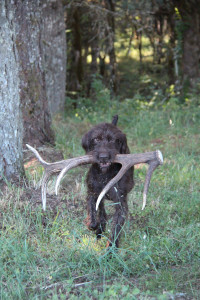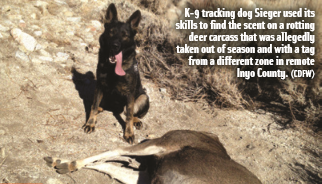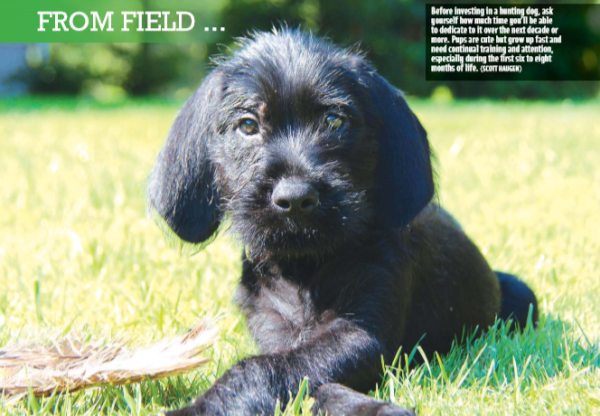In Search of Sheds
LOOKING FOR A NEW ACTIVITY FOR YOUR HUNTING DOG? SNIFF OUT FRESHLY DROPPED DEER ANTLERS IN SPRING.
By Scott Haugen
Hunting for deer and elk antler sheds has skyrocketed in popularity over the past decade. Not only do hunters learn what bucks and bulls are in their hunting areas by finding sheds, but nonhunters, artists and collectors are getting bit by the craze too.
Shed hunting is like an Easter egg hunt, as you know the antlers are out there; it’s just a matter of finding them. From Rocky Mountain elk to mule deer, brush-country Roosevelt elk to blacktails, using a dog can greatly increase the odds of locating antler sheds.

weigh their impact on winter-weakened animals. (SCOTT HAUGEN)
However, just because you have a dog, don’t head into the woods under the misconception that simply turning Rover loose will result in a pack full of sheds. Think of where bucks and bulls are this time of year and over the next couple months, and start there.
GO IN THE RIGHT DIRECTION
South-facing slopes are where many of these animals live this time of year. Here they can soak up the sun and feast on the first of the green grasses of spring.
Bigger bucks often bed toward the tops of south-facing ridges, where they have a commanding view. Some bucks and bulls will hang out in brushy fringes on these southern slopes. Some bull elk live in the deepest, darkest canyons.
At lower elevation, where nonmigratory animals live, brushier habitat is the norm. Keep in mind that the movement of these animals is minimal in February and into March, especially during hard winters. Their food sources have held little nutrition since November, and in anticipation of spring’s arrival, they travel little in an effort to conserve energy. Scouring the ground of these slopes that face south can take days, so narrow down your search for antlers by focusing on bedding areas and trails – especially where trails cross over downed trees, creeks and fences.
Whenever a buck or bull has to jump to get over an obstacle, the likelihood of their antlers popping off increases. As the pedicles weaken, a jolt to the body – even a headshake – is all it takes to pop the bone from their head. This is why bedding areas are also great places to search for sheds, because a buck or bull often shakes as it gets up, dislodging the antlers. In order to maximize your dog’s chance of locating sheds, these are the habitats you want to turn them loose in.
DOG DETAILS
As with hunting upland birds, start the dog into the wind and encourage them to range out. But don’t send them out too far, as the last thing you want is them chasing game. If shed hunting in migratory wintering grounds, don’t use a dog until the animals have moved out, usually by late March.
I use an electronic collar when shed hunting with a dog, but not for the shock feature; I use it for the GPS option. When the dog works thick brush and big, brushy timber, you want to know where they are.
If your dog has never hunted antler sheds, they can be taught. Start by introducing them to an antler you have – either a shed or one cut from a buck you’ve taken. Thoroughly wash the antler with borax soap to remove any human odor. From that point on, only handle the antler with rubber gloves. You want the dog to familiarize itself with the scent of the antler, not the oils from your hands.
To “freshen up” an antler so the dog will be attracted to its scent, breaking off the tip of a tine or scoring the main beams with a file or abrasive paper will help. Give the antler to your dog, but only for a minute or two. You do not want the antler to become a chew toy, and you want to take it away from them with their interest piqued.
When first teaching the dog to find the antler, place it in the yard in an easy-to-find location. Don’t let the dog see you plant it. Once the dogs find the planted antler with regularity, it’s time to head into the hills or the brush. With the dog kenneled, plant a few antlers by tossing them away from the trail on which you’re standing. You don’t want the dog following the smell of your boots to where you set the antler, so toss it 10 to 20 yards off the trail, making sure it doesn’t get hung up in any brush. Remember where you toss them, just in case the dog can’t locate them.
Once your dog picks up the tossed, planted sheds, it’s time to get them on the real deal. Stuff a training antler in your pack when hunting for sheds, just in case you don’t find anything that day. The shed you take can be planted to reward your dog with success. You want them to have success so they develop the drive of wanting more.

(SCOTT HAUGEN)
FUN FOR YOUR BEST FRIEND
Echo, my 2-year-old pudelpointer, loves looking for sheds, and that’s one of the reasons I was attracted to this breed (not to mention the fact they are proficient with upland birds, waterfowl and blood trailing). Any dog that hunts birds can be taught to find sheds, and I’ve seen success with many breeds, especially Labradors early and late in the day before it gets too hot out.
As winter turns to spring, and antlers start dropping, now is a great time to be afield, searching for sheds. Not only is shed hunting a bonus for getting your dog into the field and both of you in shape, it can open your eyes to just how many bucks and bulls are really out there.
Editor’s note: For signed copies of Scott Haugen’s popular adventure book, Life In The Scope: The West, send a check for $15(free S&H) to Haugen Enterprises, P.O. Box 275, W97489, or visit scotthaugen.com. Follow Scott on Instagram, Twitter and Facebook.



